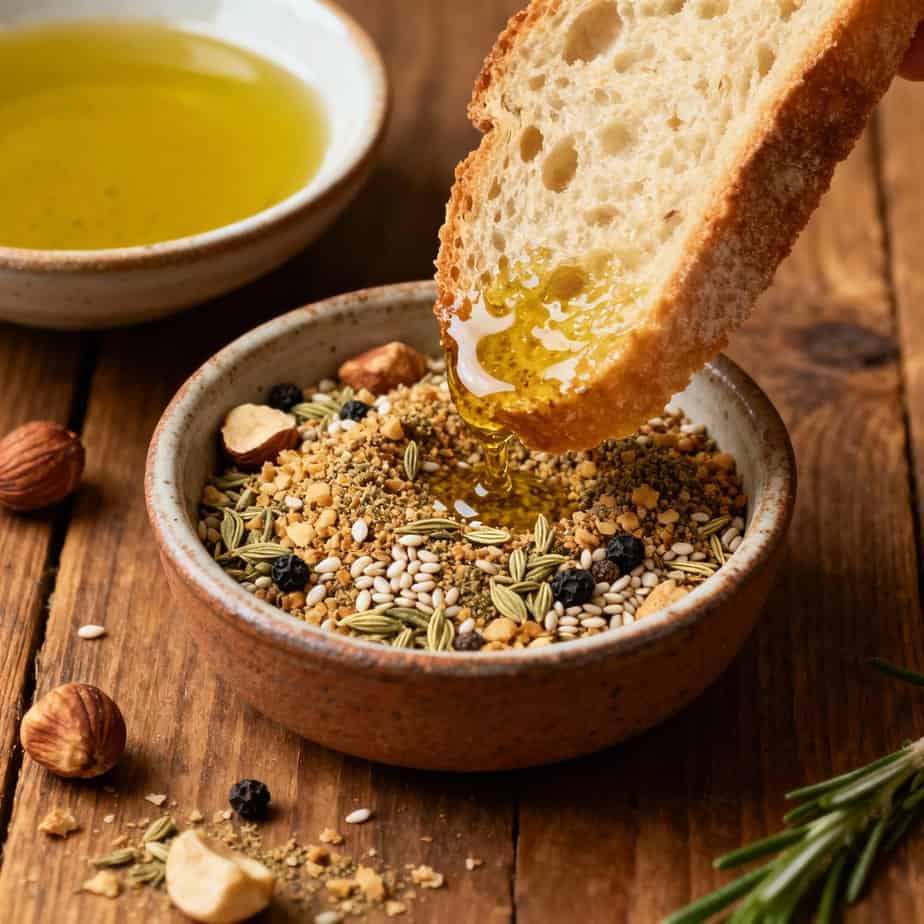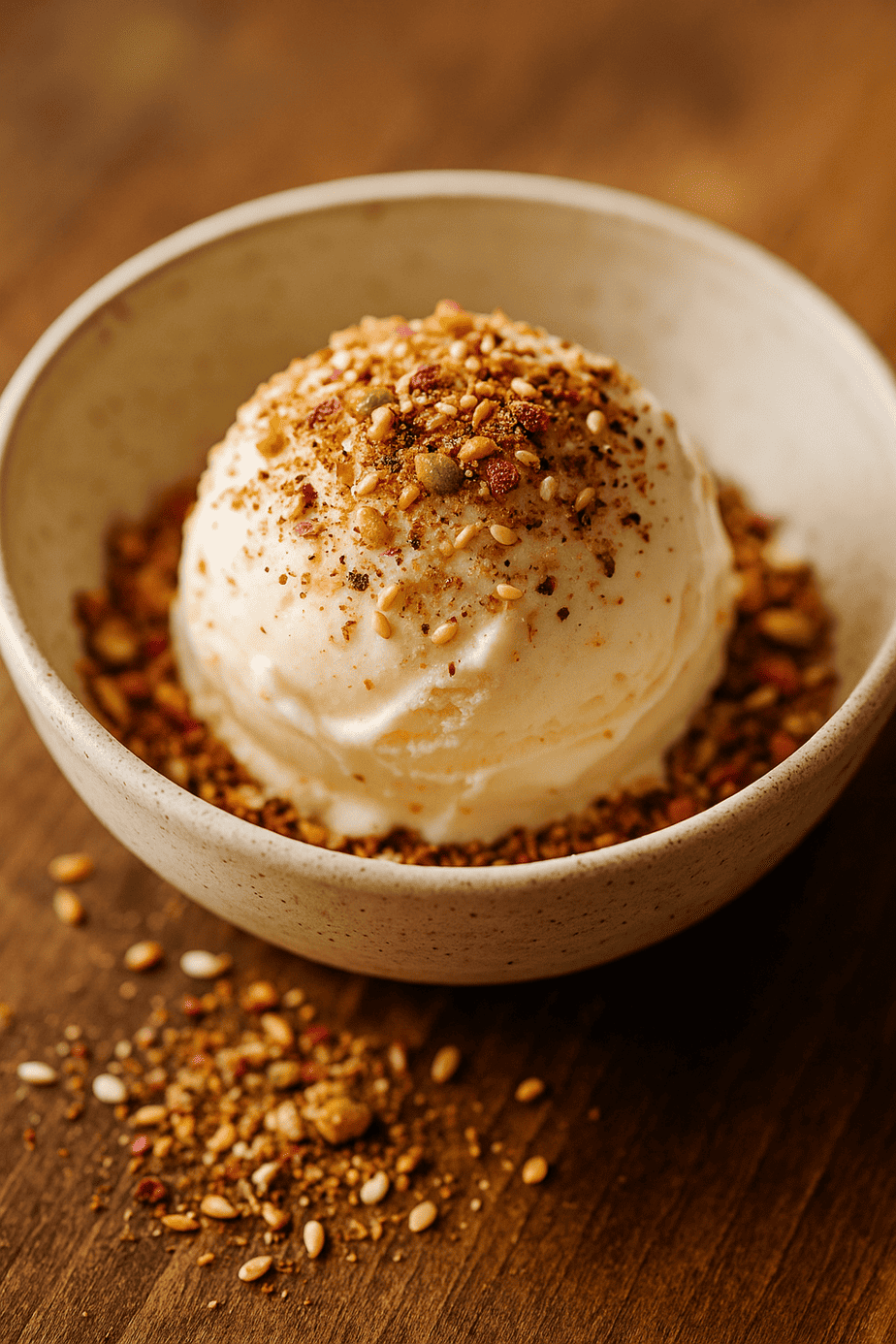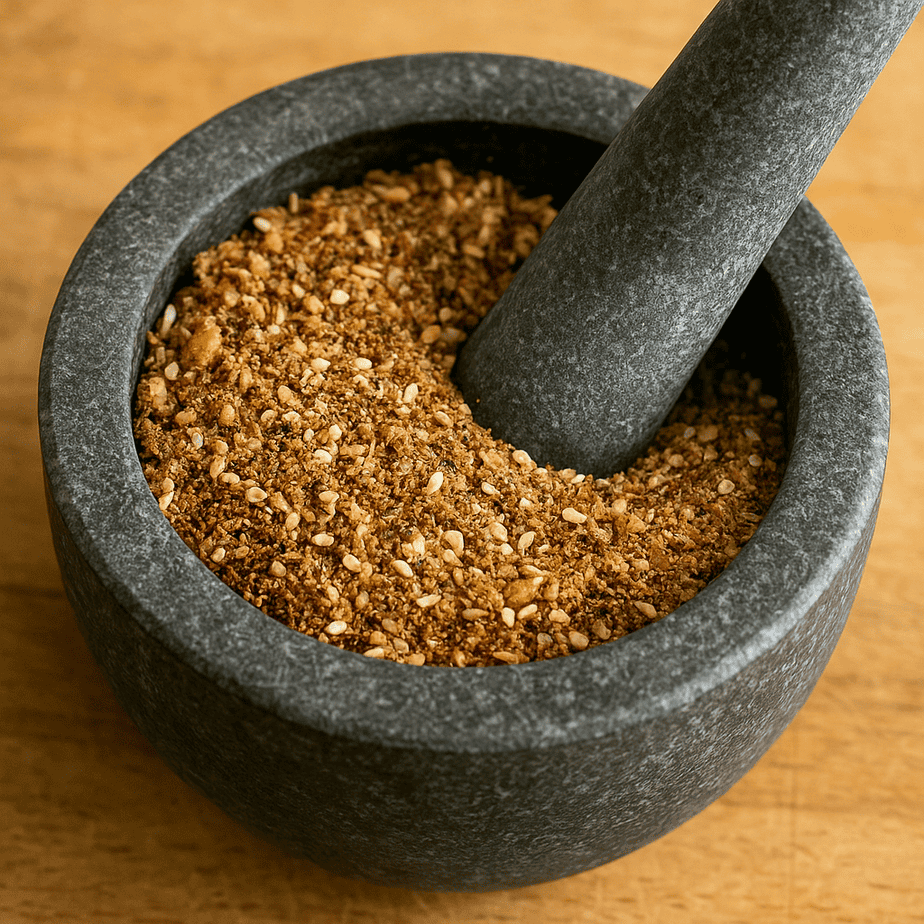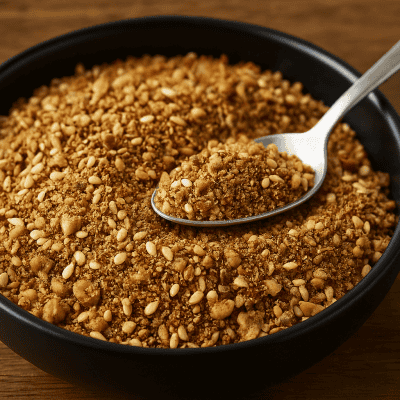A while back, my father-in-law, who loves to try new gourmet foods, sent us a tin of dukkah, a fragrant Egyptian blend of toasted nuts, seeds, and spices. One taste and I was hooked. This aromatic mix transformed everything I sprinkled it on, from simple roasted vegetables to morning eggs.
With the tin nearly empty, I knew I had to learn to make my own batch. There’s something beautiful about receiving a gift that leads you to discover a whole tradition. Now I’m sharing this homemade dukkah recipe with you, along with all the creative ways you can use it in your kitchen.
What is Dukkah?
Dukkah (sometimes spelled “duqqa” or “dukka”) is a traditional Egyptian condiment that defies simple categorization:
- Spice Blend: Dukkah is a blend of toasted spices and seeds, coarsely ground with nuts, used as an all-purpose seasoning, rub, or dip.
- Nut and Seed Topping: Crunchy and nutritious, dukkah adds flavor and texture to grain bowls, salads, roasted vegetables, and eggs.
- Condiment or Crust: Traditionally served with bread and olive oil or used as a crust for meat or fish.
Dukkah isn’t just a seasoning or garnish. Think of it as a food experience: a fragrant, toasty moment that brings texture, aroma, and excitement to each bite. Every sprinkle is a mini celebration for your senses.
The Story Behind Dukkah
Dukkah has its roots in ancient Egypt, where it was originally created as a portable, nutrient-dense food that didn’t spoil in the heat. Egyptian street vendors would sell it by the scoop, and families would make their own signature blends, passing recipes down through generations. The name comes from the Arabic word for “to pound” or “to crush,” referring to the traditional method of crushing the ingredients with a mortar and pestle.
There’s something deeply meaningful about a food tradition that has nourished families for thousands of years. In a world of processed convenience foods, making dukkah connects us to the patience and intentionality of generations past. It’s a reminder that the best things are often created by hand, with care, and with gratitude for the simple ingredients God provided from the earth.
What I love most about dukkah is that there’s no single “correct” recipe. Every family, region, and cook puts their own unique spin on it, making each batch a little different and deeply personal. Some versions are nuttier, others more aromatic with spices.
God’s Wisdom in Everyday Ingredients
Despite this variety, dukkah’s magic lies in its simplicity: just everyday nuts, seeds, and spices, skillfully toasted and combined. This gracious flexibility means you can tailor it to your taste and pantry staples. It’s a beautiful reminder of how God works, taking the ordinary and, through a bit of heat, time, and loving care, transforming it into something extraordinary and nourishing. You can do the same with your homemade dukkah.
In fact, dukkah is a fantastic way to use up odds and ends in your pantry. Have a handful of almonds left? A few tablespoons of sesame seeds? Half a bag of pistachios? Dukkah is forgiving and adaptable. This makes it perfect for frugal cooking and reducing food waste—values that align beautifully with mindful, sustainable living.
Nutritional Benefits of Dukkah
Beyond flavor, this homemade dukkah recipe delivers major health benefits:
Healthy Fats: Nuts and seeds provide heart-healthy monounsaturated and polyunsaturated fats that support brain function and reduce inflammation.
Protein and Fiber: The combination of nuts and seeds delivers plant-based protein and fiber, helping you feel satisfied while supporting digestive health.
Minerals: Sesame seeds are rich in calcium, iron, and magnesium. Hazelnuts and almonds provide vitamin E, manganese, and copper.
Antioxidants: Cumin, coriander, and fennel seeds contain antioxidants that combat oxidative stress and support immune function.
Anti-inflammatory Compounds: Many of the spices in dukkah have natural anti-inflammatory properties that support overall wellness.
Diet-Friendly: Dukkah naturally fits paleo, vegan, gluten-free, and keto diets. It’s also easy to customize for nut allergies by using only seeds or for low-FODMAP diets by adjusting the spice blend.
This isn’t just a flavor enhancer. It’s a way to add serious nutrition to everyday meals. You can swap any nut or seed, too. Hazelnuts are classic, but almonds, pistachios, walnuts, sesame, sunflower, pumpkin, and flax are also common and work perfectly. However, flaxseeds should not be toasted and should be added to the mix after toasting as heat can damage their beneficial omega-3 fatty acids.
Store-Bought vs. Homemade: The Real Cost
Dukkah is increasingly available at specialty grocers, Middle Eastern markets, and online. The tin my father-in-law gave us from Silk Road (a 2-ounce Egyptian Dukkah) sells on Amazon for $10.98 ($5.49 per ounce) and has:
- 1,500+ glowing reviews
- Pure hazelnut-coriander-sesame blend, no salt
Conversely, my homemade dukkah recipe makes 3/4 cup (about 4 oz) for approximately $1.20 total in bulk-bin ingredients, or 30¢ per ounce.
Thus, you save $20.76 per batch (store-bought: $21.96 for 4 oz vs. homemade: $1.20 for 4 oz).
Beyond the dramatic cost savings, homemade dukkah is fresher (you control the roasting), more customizable (adjust nuts and spices, to your taste), and you know exactly what’s in it. Store-bought versions, while convenient, lose their freshness quickly once opened.
15 Ways to Use Your Homemade Dukkah
Once you make your first batch, you’ll start finding excuses to use it everywhere. Here are 15 delightful ways:
- Traditional Bread Dip: Pour olive oil into a shallow dish, then dip warm bread first in the oil, then in dukkah. This is how it’s traditionally served in Egypt, and it’s absolutely addictive.
- On Roasted Vegetables: Sprinkle dukkah over roasted cauliflower, carrots, sweet potatoes, or Brussels sprouts in the last few minutes of cooking.
- Salad Topper: Add a tablespoon to any green salad for instant crunch and flavor. It pairs especially well with Middle Eastern-inspired salads.
- Avocado Toast Upgrade: Mash avocado on toast, drizzle with olive oil, and generously sprinkle with dukkah.
- Protein Crust or Coating: For a flavorful coating on fish, chicken, or lamb, brush the surface lightly with your choice of olive oil, beaten egg, or yogurt. Then, press dukkah onto the surface before pan-searing or roasting.
- Egg Enhancement: Sprinkle over scrambled eggs, fried eggs, deviled eggs, or egg salad.
- Grain Bowl Garnish: Top quinoa bowls, rice bowls, or farro bowls with a spoonful of dukkah for added texture and nutrition.
- Yogurt or Labneh Dip: Mix dukkah into Greek yogurt or labneh with a drizzle of olive oil for a quick, impressive appetizer.
- Hummus Topping: Create a well in your hummus, fill it with olive oil, and sprinkle dukkah over the top.
- Popcorn Seasoning: Toss hot, buttered popcorn with dukkah for a savory, crunchy snack that’s uniquely delicious.
- Soft Cheese: Roll balls or logs of goat cheese, ricotta, or labneh in dukkah for an instant appetizer or salad topper.
- Soups: Sprinkle dukkah over creamy vegetable soups (like carrot, sweet potato, tomato, or squash) to add crunch and extra spice.
- Crackers & Breadsticks: Mix dukkah into homemade cracker dough, or sprinkle on breadsticks before baking for a gourmet snack.
- Pizza & Flatbread: Scatter dukkah over homemade pizza or flatbreads in the last minutes of baking for added crunch and aroma.
- Sweet Dukkah for Desserts: Dukkah isn’t just for savory dishes! Make a sweet version with cinnamon, fennel, cardamom, and rose petals to sprinkle over vanilla ice cream, yogurt with berries, fruit salads, or chocolate mousse.
For a floral, Middle Eastern-inspired twist, try my Persian Rose blend of organic cinnamon, cardamom, coriander, nutmeg, rose petals, and pomegranate. It’s beautiful on fruit and dark chocolate as well as beef and lamb.
Once you try homemade dukkah, you’ll find yourself reaching for it again and again, discovering just how versatile this Egyptian spice blend truly is.
Frequently Asked Questions about Dukkah
How do you pronounce dukkah?
It’s “DOO-kah” (rhymes with hookah). You’ll also see it spelled duqqa or dukka.
What does dukkah taste like?
Warm, nutty, gently spicy with toasted cumin and coriander. Crunchy and earthy—never overpowering.
Can I make nut-free dukkah?
Yes. Skip the nuts, bump sesame seeds to ⅓ cup, and add sunflower or pumpkin seeds.
How long does homemade dukkah last?
Peak flavor: 1 week. Airtight jar = 2 weeks pantry, 1 month fridge, 2 months freezer.
Can I make dukkah without a food processor?
Yes. Use a mortar & pestle or rolling pin + zip-bag, and crush to your desired texture.
Get in the Kitchen!
I love flexible, make-it-your-own recipes, and this homemade dukkah recipe is a home run in that department. Every batch can be completely different, tailored to your dietary needs and what you have on hand. I haven’t tried all the possible combinations yet, but I can’t wait to experiment with more variations when my current batch runs out. In any case, you’re bound to end up with something truly special.
Homemade Dukkah Recipe
Ingredients
- 1/3 cup toasted hazelnuts or almonds
- 1/4 cup toasted pistachios, (optional)
- 2 tablespoons sesame seeds
- 2 teaspoons coriander seeds
- 1 teaspoon cumin seeds
- 1/2 teaspoon fennel seeds, (optional)
- 1/4 teaspoon sea salt
Instructions
- Toast the nuts in a dry skillet over medium heat for 3 to 4 minutes, until fragrant and lightly golden. Transfer to a plate to cool.
- Toast the sesame seeds and spices in the same skillet until fragrant, about 2 to 3 minutes. Transfer to the plate with nuts.
- Allow everything to cool completely, about 5 minutes.
- Add the cooled nuts, seeds, and salt to a food processor. Pulse 8 to 10 times until coarsely ground with visible texture. Some prefer it chunky, others finer, but not a powder.
- Dukkah tastes best within the first week, but it can be stored in an airtight container for up to 2 weeks, or in the freezer up to 2 months.







